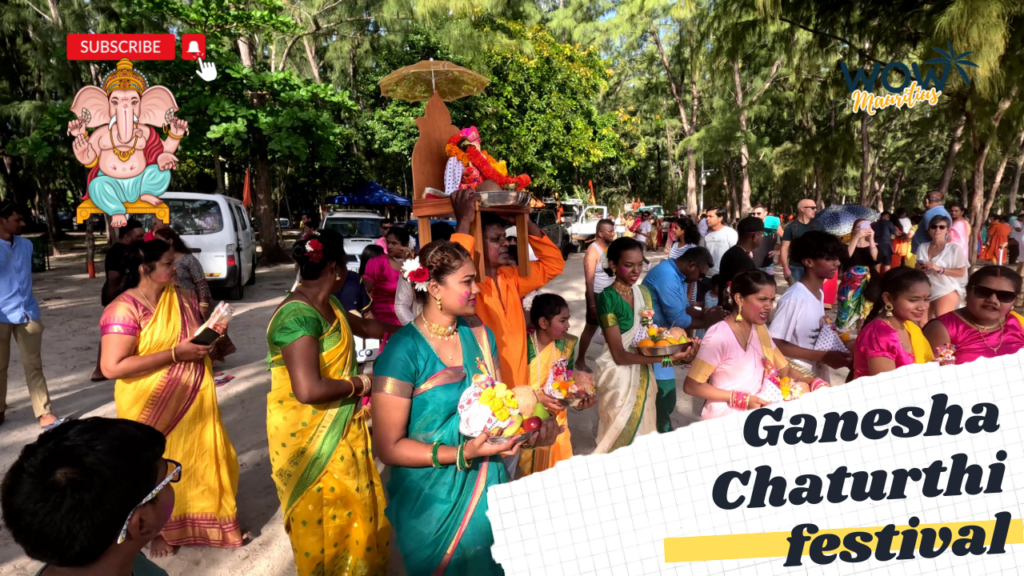Have you heard of Ganesh Chaturthi? If not, be sure to join me, because I recently attended this wonderful fairytale celebration, the atmosphere of which I’m trying to put into words so that you can share in the magic.
Where do I start? Perhaps a little introduction to who Ganesha is and why it is so important to locals. He is the ONLY dominant god of Hindu culture (indeed, there are many gods in their religion!) and he has several ‘duties’: he is seen as the helper of beginnings, the remover of obstacles, the guardian of abundance, beauty and wisdom, the caretaker of the universe. Much could be written about his birth and why he is depicted with the head of an elephant, but I will talk about that in another post.
So, the festival: in this event, devotees ask Ganesha for his blessings and help to get rid of their life problems or even to grant their wishes. The festival itself, as is Hindu custom (see weddings), lasts for several days. There is no fixed date, but depending on the lunar cycle, it is either at the end of August or the beginning of September, which covers 10 days.
We attended the last day of the festival, which was the most spectacular. On this holy day, everything closes and people, young and old, head for the ocean shore. So we did, we got in the car and we drove down…because all the roads were blocked but that didn’t make anyone grumble, the spirit of Ganesha brought joy and peace to everyone on the way. We could see floats decorated with colourful flowers, pass by groups of people in procession, and holy songs and melodies filled the entire route. And so, by the time we arrived, we were in the spirit of the event.
I knew from the first moment that I was going to need all my senses here: suddenly I could see all the colours and shades of the colour palette! But not the discreet pastels that we are used to as Europeans, but the amazing, vibrant yellows, greens, blues, all the colours and tones of the rainbow that I had last seen in storybooks as a child. The ladies were resplendent in beautifully coloured and meticulously embellished saris with lots of accessories (the less is more rule doesn’t play here), yet it gave them a totally harmonious look.
Families placed their statues of Ganesha in the sand, accompanied by music and prayers, and then the ceremony began, and with it my journey to learn about a unique religion. At first, I stood hesitantly, not wanting to disturb the celebrants, and I took photographs only timidly. But very soon I realised that they were very welcoming to people from other cultures, and with a big smile and openness they invited me to join them with my daughter. So I was allowed to be an honorary member of three families, and they tried to explain to me what was happening and what to do. It also turned out to be a very good decision to take our Ganesha statue (obviously appropriated by the child), which we had bought when we moved here, with us. He was also lined up in the sand next to his effigies, although he was dwarfed by the huge and very imposing Ganesha, resplendent in all the colours of the rainbow.
The ritual itself can vary from family to family and from community to community, sometimes longer, sometimes shorter, sometimes performed by Hindu priests with the participation of the people present, sometimes by a member of the family.
The food offered to the celebrant was then placed in front of the statues: mainly rice, coloured yellow with saffron, milk, and, since Ganesha is considered to have a sweet tooth, various small cakes and coconuts, which are considered to be the food of elephants, and by breaking them open, we please the deity, as it helps them to get their food, and breaking open the fruit symbolizes overcoming the obstacles of life, for which Ganesha is asked to help. And the essential incense bundles and candles, which help to bring the mind and soul into a sufficiently spiritual and relaxed state, were also not missing. Meanwhile, Hindu prayers and chants lilted the shore. We whispered our wishes into the ears of the Ganesha statues, completely soaked in the pleasant sandalwood fragrance of the incense burners, the cavalcade of colours, the melody of the drums and songs and the ensemble of peace and love emanating from the people. The ladies presented us with the distinctive bindi (red dot between the eyebrows) and anointed each other and our faces with a pleasant smelling red powder, which symbolises joy, fire and the festival itself, among other things.
Then it was time for another dance. Here, in a ceremony led by the priest, a small sacrificial fire (havan) was improvised in a pit dug in the sand, and since the number seven is considered a sacred number in their faith, we had to go around the small pit seven times. In the meantime, short mantras were recited, at the end of which a pinch of fragrant spice mix, rice and millet – which we were strictly allowed to hold in our left hand and had to circle around our head seven times – was sprinkled into the flames, and some coconut and ghee (clarified butter) were also added.
The function of the fire is to bring the prayers and offerings to Ganesha. At the end of the fire ceremony, the priest blessed a coconut, which he later cracked and sprinkled all the elephant statues with its water.
Finally, the Ganesha statues are immersed in the ocean (although any body of water nearby will do) to symbolise Ganesha’s return home. Each member of the community took one of the statues, so we picked up our tiny but now blessed idol and slowly floated into the ocean, with our backs to the ocean, while those on the shore said farewell to their beloved god. A couple of times we were completely submerged and then we left the statues and came out of the water (True, my little daughter refused to part with her little Ganesha so she didn’t stay with her companions in the water..).
Although a large number of these beautifully crafted idols are thrown into the water at this time of year, they are now largely made of biodegradable materials and natural dyes in an attempt to protect the environment. And by morning, the ocean beach will be back to its former glory, thanks to the diligent hands of the cleaners (who keep the beaches clean all day, every day of the week).
With Ganesha’s return, the sun also bid us farewell, so we said goodbye to our hosts and headed home. On the way, I could smell the sandalwood, hear the beat of the drums, see the cavalcade of colours, but most of all I felt the joy and peace of the openness and welcome of the locals. I wish them with all my heart that all the wishes they have whispered in the ears of their beloved God will come true.
And our little “runaway” Ganesha statue is still dripping in coconut water and sand and there are still some flower petals and splinters here and there but we won’t wash them off for a while..



